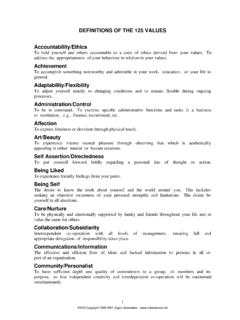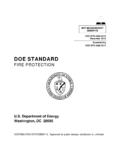Transcription of EH-93-4 The Fire Below: Spontaneous Combustion …
1 EH-93-4 The fire below : Spontaneous Combustion in Coal ENVIRONMENT SAFETY & HEALTH BULLETINA ssistant Secretary for U. S. Department of EnergyEnvironment, Safety & Health Washington, 20585 DOE/EH-0320 Issue No. 93-4 May 1993------------------------------------ -------------------------------------THE fire below : Spontaneous Combustion IN COAL------------------------------------ -------------------------------------How Coal Self-IgnitesThe coal's temperature begins to climb above ambient. At about 150-300degrees F, it begins to give off minute, but measurable, quantities ofgas--aerosols, hydrogen, and CO(2)--precursors of Combustion . As thetemperature increases further--at about 600-700 degrees F--relatively,large, visible particulates are emitted. Soon, as the heating rateincreases in intensity to about 750-800 degrees F, incipient Combustion ,and ultimately self-ignition and flame, will least a dozen coal fires occurred within the Department of Energy (DOE)over the last decade.
2 Seven sites were involved, with two of the sevenexperiencing multiple incidents. Fortunately, none of the fires resultedin fatalities. However, damages from all but one ran into the thousandsof dollars, and the most severe incident caused a minimum os $800, risk from fire exists anywhere significant amounts of coal are in useor storage. Coal is a combustible material, making it susceptible to avariety of ignition scenarios. One of the most frequent and seriouscauses of coal fires in Spontaneous Combustion , which has been responsiblefor a number of incidents within the Department in recent Spontaneous Combustion coal fires involves attention to manydifferent factors. Among the most critical are the type, age, andcomposition of coal, how it is stored, and how it is used. Given theright kind of coal, oxygen, and a certain temperature and moisturecontent, coal will burn by Combustion has long been recognized as a fire hazard in storedcoal.
3 Spontaneous Combustion fires usually begin as "hot spots" deepwithin the reserve of coal. The hot spots appear when coal absorbs oxygenfrom the air. Heat generated by the oxidation then initiated the fires can be very stubborn to extinguish because of the amount ofcoal involved (often hundreds of tons) and the difficulty of getting tothe seat of the problem. Moreover, coal in either the smoldering offlaming stage may produce copious amounts of methane and carbon monoxidegases. In addition to their toxicity, these gases are highly explosive incertain concentrations, and can further complicate efforts to fight thistype of coal the most universal firefighting substance, water, cannot be usedindiscriminately. Because of the remote possibility of a steam explosion,it is advisable that water be applied carefully and from a safe chemicals such as carbon dioxide or nitrogen may mitigate fireeffects, but their use has had mixed success from a DOE perspective.
4 Theabove information suggests that coal fires require awareness and priorplanning to extinguish efficiently, completely, and Coal fire at DOE SiteIn 1992, a DOE site experienced its most recent coal fire initiated byspontaneous Combustion . Due to the nature of the fire and initialineffectiveness of the means utilized to fight it, the fire required morethan 28 hours to completely extinguish from the time a hot spot was firstdetected in the coal bunker. The initial strategy involved trying toremove coal from the bunker by feeding it more rapidly to the boiler andby using a drag chain to move more of it to the field. The drag chainfailed in 30 minutes, however. Subsequent efforts to control the firewith carbon dioxide applied through inspection ports at the bottom of thebunker and from the tripper room high above the bunker were ineffective,and may have worsened the situation. The drag chain emptying coal fromthe bunker worked intermittently after being repaired, and finallystopped.
5 Boiler plant personnel then began to remove burning coal by hours after the fire was discovered, it had involved a largeamount of the bunker. At one point, flames appeared at the tripped roomwindows, which are approximately 75 feet above the seat of the hot strong concern for a steam explosion delayed the application of water,but the decision was finally made to use water, which was applied withoutincident and eventually ended the of Spontaneous Coal FiresThe incident related above serves as an excellent case study of aspontaneous Combustion coal fire . It illustrated some major causes ofsuch fires as well as the problems of fighting them effectively andsafety. The following general factors have been mentioned as contributingcauses:o Coal handling procedures allowed for long-time retention of coal, which increases the possibility of New coal added on top of old coal created segregation of particle sizes, which is a major cause of Too few temperature probes installed in the coal bunker resulted in an excessive period of time before the fire was Failure of equipment needed to fight the fire (drag chain conveyer).
6 O Ineffective capability and use of carbon dioxide fire suppression Delay in the application of Inadequate policies, procedures, and training of personnel prevented proper decision making, including the required knowledge to immediately attack the Failure to learn lessons from two previous coal bunker fires at the same Coal Fires in the Last DecadeOther coal fires caused by Spontaneous Combustion have occurred at DOEfacilities in the last decade. In 1985 Spontaneous Combustion wasresponsible for starting two fires in a coal bunker at a DOE site. Thefires were extinguished by injecting gaseous nitrogen into the bunker nearthe hot spots. The cause was determined to be the excessive storage timeof the coal. In addition, excessive compaction caused by fines (finelycrushed coal) contributed to the rate of 1991 at another DOE site, a smoldering fire was discovered in an unusedcoal bunker which had accumulated 2 cubic feet of coal dust from anoverhead coal conveyer system.
7 The fire was believed to have startedspontaneously, through careless smoking was also listed as a possiblecause. At still another site, coal stored too long in a silo ignited dueto Spontaneous unusual fire which occurred in 1991 illustrates the opportunisticnature of Spontaneous Combustion on coal. A backhoe had been sitting for3 hours after the close of work. For the previous 2 days, the backhoe hadbeen mucking out slag and coal collection ponds to remove coal fines. Asecurity guard noticed a fire on the backhoe rear tire. Facilitypersonnel believe the cause of the fire was Spontaneous Combustion of thecoal fines which had adhered to the tire. Some of the thick coal mud inthe ponds had not been exposed to oxygen until it was churned up by thetires of the backhoe. Personnel were instructed to wash equipment tireswhen leaving the ponds for the Spontaneous Combustion in Stored CoalHugh quantities of coal are stored in bunkers, silos, hoppers and open airstockpiles.
8 How susceptible such stocks of coal are to fire fromspontaneous Combustion depends on a number of factors, from how new thecoal is to how it is :o Know your coal. Anthracite (sometimes called eastern coal) has a high carbon content and is much less combustible than low oxygen content bituminous (or western) coal. Freshly mined coal absorbs oxygen more quickly than coal mined at an earlier time, and is more likely to head Storing coal with a low sulphur content is helpful. Sulphur compounds in coal liberate considerable heat as they Air circulating within a coal pile should be restricted as it contributes to heating; compacting helps seal air Moisture in coal contributes to Spontaneous heating because it assists the oxidation process. Moisture content should be limited to 3 percent; sulphur content should be limited to 1 percent, "as mined." Coal having a high moisture content should be segregated and used as quickly as possible.
9 Efforts should be made to keep stored coal from being exposed to Following the "first in, first out" rule of using stock reduces the chance for hot spots by helping preclude heat buildup for portions:: of stock which remain undisturbed for a long term. The design of coal storage bins is important in this A high ambient temperature aids the Spontaneous heating Use coal as quickly as practicable. The longer large coal piles are allowed to sit, the more time the Spontaneous process has to The shape and composition of open stockpiles can help prevent fires. Dumping coal into a big pile with a trestle or grab bucket can lead to problems. Rather, coal should be packed in horizontal layers (opinions range from 1 1/2' to 3' high) which are then leveled by scraping and compacted by rolling (See Figure 1, not included in SPMS, see original Bulletin for Figure).
10 This method helps distribute the coal evenly and thus avoids breakage and segregation of fine coal. Segregation of coal particles by size should be strenuously avoided, as it may allow more air to enter the pile and subsequent heating of finer The height of the coal pile is also important. Limit unlayered, uncompacted high grade coal to a height of 15' (10' for low grade coal); maximum height is 26' for layered and packed Properly inspect, test and maintain installed fire protection Maintain an updated pre- fire plan and encourage regular visits to coal facilities by the site or local emergency response 1 (Not included, see original Bulletin). Poor distribution of fineand coarse coal resulting from dumping from a high trestle or grab bucketwithout rolling (above), compared with good distribution and exclusion ofair by roll-packing method. (Illustration courtesy of Factory MutualEngineering Corp.)





